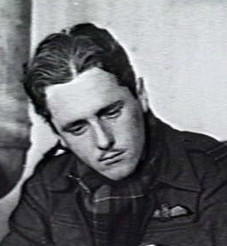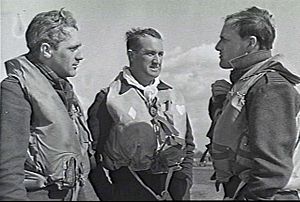Harold North facts for kids
Quick facts for kids
Harold Leslie North
|
|
|---|---|
 |
|
| Nickname(s) | Knockers |
| Born | 31 October 1919 Dunedin, New Zealand |
| Died | 1 May 1942 (aged 22) France |
| Allegiance | New Zealand |
| Service/ |
Royal Air Force (1938–1942) |
| Rank | Flight Lieutenant |
| Service number | 41608 |
| Unit | No. 43 Squadron No. 96 Squadron No. 457 Squadron |
| Battles/wars | Second World War
|
| Awards | Distinguished Flying Cross |
Harold Leslie North, also known as 'Knockers', was a brave New Zealand pilot. He flew for the Royal Air Force (RAF) during the Second World War. He was known as a "flying ace" because he shot down at least five German planes.
Born in Dunedin in 1919, North joined the RAF in 1938. He flew Hawker Hurricane fighter planes during the Battle of Britain. He shot down several enemy aircraft during this time. Later, he was promoted to flight lieutenant. He then flew Supermarine Spitfire planes with No. 457 Squadron. On May 1, 1942, he flew a mission to France. He was last seen fighting German planes and was believed to have been killed. He was given the Distinguished Flying Cross for his courage after his death.
Contents
Early Life and Training
Harold Leslie North was born on October 31, 1919, in Dunedin, New Zealand. His parents were William and Ruby North. He went to Otago Boys' High School from 1933 to 1935. After that, he studied at Wellington Technical College. He later worked as a law clerk in Wellington.
In early 1938, Harold wanted to join the Royal Air Force (RAF). He applied to become an officer. His application was accepted, and he traveled to the United Kingdom in September. He sailed on the ship RMS Rangitane.
Harold, who was nicknamed 'Knockers', began his pilot training on October 31. This was at No. 12 Elementary and Reserve Flying Training School in Prestwick. In January 1939, he went to Uxbridge. He officially became an officer and was given the service number 41608. He continued his flight training at No. 9 Flying Training School. There, he earned his pilot's "wings" in May. He then received more advanced training. In early September, he became a probationary pilot officer.
Second World War Service
When the Second World War began, North was sent to No. 43 Squadron. This squadron was based at Acklington. They flew Hawker Hurricane fighter planes. From late 1939 to early 1940, the squadron protected ships along the coast. North was confirmed in his rank as a pilot officer.
In February, the squadron moved to Wick in northern Scotland. They protected the Royal Navy base at Scapa Flow until May. Then, they moved back south to Tangmere. They immediately helped cover the beaches at Dunkirk. This was during Operation Dynamo, when British soldiers were being evacuated from France. The squadron lost many planes and pilots during this time. They had to stop flying for a while to get more planes and pilots.
In July, the squadron returned to action. They were briefly based at Northolt. They flew with Bristol Blenheim bombers on daytime raids to France. They also did patrols at night. The next month, they were back at Tangmere. This was when the Battle of Britain became very intense.
Battle of Britain Heroics
On August 18, North and other pilots fought a large group of German planes. These were Junkers Ju 87 dive bombers. They were getting ready to attack a radar station. North shot down one Ju 87 over Thorney Island. He was also credited with probably destroying another.
On August 26, North was leading a group of planes. They fought Heinkel He 111 bombers and their escorting Messerschmitt Bf 109 fighters. He shot down one He 111. However, his Hurricane plane was damaged by cannon fire from a Bf 109. He was wounded. Despite this, he fought another He 111 and probably destroyed it. He then parachuted out of his plane and landed safely. He broke a finger. He was treated at Royal Sussex Hospital for wounds to his arm and shoulder. He also had small pieces of plastic from his plane's canopy in his eyes.
North was promoted to flying officer. He returned to No. 43 Squadron on September 10. He was already having kidney problems, and his wounds continued to bother him. A friend said that small pieces of shrapnel would often come out of his arms.
When North returned, No. 43 Squadron had moved to Usworth near Newcastle. In mid-December, he was sent to No. 96 Squadron. This squadron was forming at Cranage. It was a night fighter squadron, flying Hurricanes. Their job was to defend Liverpool at night. North learned how to fly at night. In March 1941, the squadron started using Boulton Paul Defiant planes. The next month, North was transferred. He was promoted to acting flight lieutenant.
Channel Front Operations
On June 23, North returned to active duty. He became a flight commander in No. 457 Squadron. This was a new Australian squadron. Most of its pilots were from Australia. However, the commander, Squadron Leader Peter Brothers, and the flight commanders were from the RAF. The ground crew were also RAF personnel.
The squadron was based at Baginton and flew Supermarine Spitfire fighters. They were training and became ready for missions in early August. They then operated from Jurby on the Isle of Man. For several months, they escorted ships and flew patrols. This squadron also trained new pilots. Experienced pilots often moved to other Australian fighter squadrons. During this time, North's rank became permanent.
No. 457 Squadron moved to Redhill in late March 1942. The RAF's Fighter Command had started flying offensive missions to France. On one of their first missions, on March 26, North destroyed a Focke Wulf 190 fighter near Le Havre. Two days later, he shot down another Fw 190 near Cap Gris Nez.
Offensive flights to France continued into April. North claimed a Fw 190 as damaged on April 4. He destroyed another Fw 190 on April 16. He also damaged one more on April 27.
On May 1, North was one of twelve Spitfires from No. 457 Squadron. They were protecting bombers attacking a factory in Marquise, France. He was seen fighting German planes about 10 miles (16 km) inland. However, he did not return to base. It is believed he was killed in action.
On June 5, it was announced that he would receive the Distinguished Flying Cross. The award recognized his bravery. It said he had commanded a flight since the squadron started. He did valuable work in training and missions. It also said he showed great courage and initiative. He had destroyed at least 5 enemy aircraft.
At the time of his death, North was credited with shooting down five German planes. He also probably destroyed two and damaged two others. Some historians believe there might be some uncertainty about this number. For example, two of his confirmed victories might have been damaged or probable instead. Harold Leslie North has no known grave. He is remembered at the Runnymede Memorial in Englefield Green.


